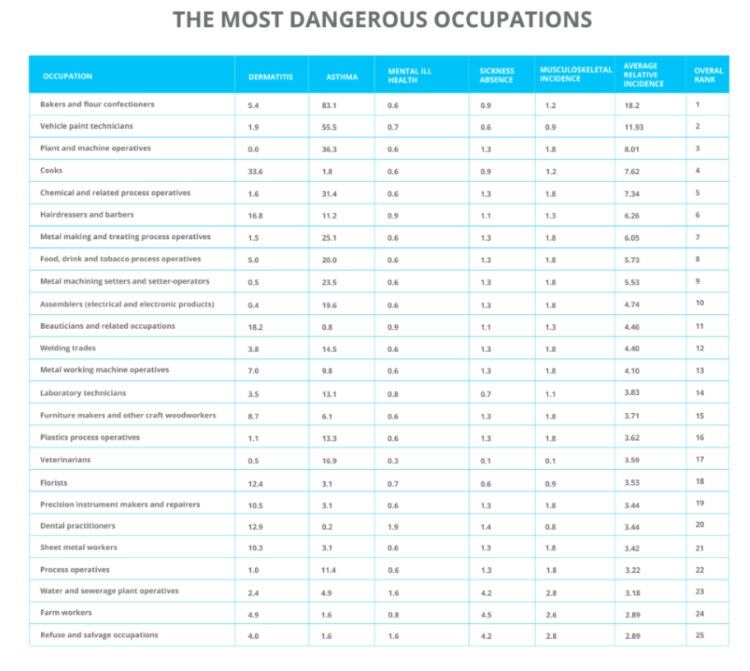The group is also 83.1 times more like than other professions to suffer from work-related asthma.
The inhalation of wheat flour, rye flour and dust cause sensitisation and sometimes result in an allergic response. It is so common that ‘Baker’s asthma’ is a well-known work-related illness.
Workplace dust and fume extraction systems specialist Extraction Solutions recently analysed the top reported cases of workplace illness in the UK to reveal the occupations that have the highest chances of sickness and injury versus the UK average.
Cooks came in fourth spot, with 7.6 times the average workplace incident.
The profession also top the list for dermatitis, being over 33.6 times more likely to get eczema than the average profession. The main causes of the inflamed and irritated skin conditions include regular use of soap, detergents and water (especially hard water), and certain ingredients like acidic citrus fruits, although this varies from person-to-person.
As with cooks, regular washing and contact with products like bleach, perming solutions and chemicals in artificial nails are key causes of dermatitis for hairdressers and beauticians. Asthma rates are encouragingly low.

Surprisingly, among the lowest risk occupations are chemical scientists.
Although undoubtedly a profession associated with a higher incident rate than most of the top 25 careers, with an average rate of illness at just 0.3, this profession sees two-thirds fewer incidents than most occupations.
The reason: chemical scientists work in a consistently sterile environment for chemical reactions, which requires a high level of personal protective equipment (PPE), along with industry-specific fume and chemical extractors to avoid any serious injury or contamination.
They also have strict exposure limits and procedures for contamination, thus limiting excessive use of regular irritants, such as flour and chemicals.
Mental health problems are common across all health sector workers, with dental practitioners topping the list at 1.9 times the most incidents.
Farmworkers are the most likely to fall ill, with 4.5 times general sickness incidents.
“Overall, it’s interesting to see the different problems facing occupations across the UK,” said David Night, marketing manager at Extraction Solutions.
“This data shows that occupational health can be at risk in any profession. Some of the most unexpected yet dangerous occupations have a long way to come to reach an appropriate level of incidents.
“Overall, this goes to show that minor irritants and chemicals can have a massive effect on health over time, which needs considering when creating safety reports and implementing new procedures.”
Research methodology
Statistics were collected from the HSE index of ill health.
The Dermatitis and Asthma Relative Incidence Rate Ratio was calculated by dividing the rate per 100,000 by the average for each incidence. The dermatitis average is 2.82 and the asthma average is 0.49.
Dermatitis rates were calculated using the THOR - Voluntary reporting of occupational diseases by specialist doctors THORSO4 report. The data used was the most recent average annual rate - the Average annual rates per 100,000 over 2016-2018p.
Asthma rates were calculated using the occupational asthma: estimated number of cases reported by chest physicians to SWORD and estimated rates per 100 000 workers per year, by occupation 2001-2018 Table THORR04 report. The data used was the most recent average annual rate - the Average annual rates per 100,000 over 2016-2018p.




